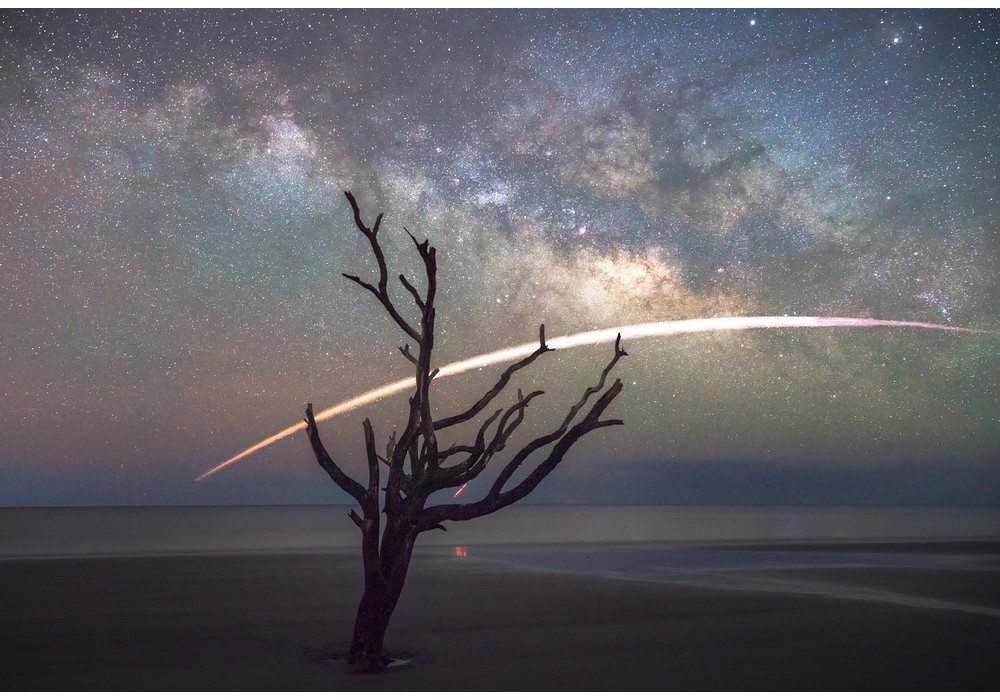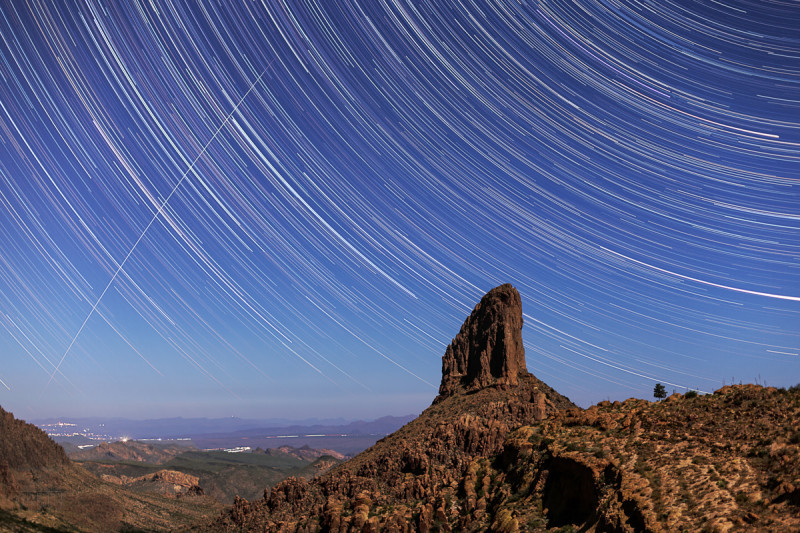Amateur photographer accidentally shot the return of Falcon 9

The first stage (in the branches of the tree) and the second stage of the Falcon 9 rocket
On May 6, 2016 at 1:21 am, the SpaceX rocket carrier of the SpaceX company launched from the spaceport at Cape Canaveral, after which it put the Japanese communications satellite into a geo-transitional orbit. But the most interesting thing started in 2 minutes 41 seconds, when the first stage of the rocket separated and headed towards the marine barge called “Of Course I Still Love You”, which made a spectacular night landing .
Shortly before, an American programmer and photographer Zach Grether climbed out of a tent on Hunting Island in South Carolina to do his favorite thing — shooting the night sky. At 1:10, he selected the appropriate tree for the background and directed his mirrorless 42-megapixel Sony a7R II to the Milky Way. Suddenly, among the stars, a fire car swept across the sky. It was a Falcon 9 rocket.
Zach Grether is not the first time shooting spacecraft. A couple of years ago, he photographed the movement of stars over the mountain Weaver's Needle near Phoenix, when the International Space Station flew into the frame.
')

Grether explains that his method of night photography involves recording a series of frames and further processing in Photoshop to remove noise. He also uses the Sony PlayMemories Time-lapse program, which is installed directly into the camera, taking a series of shots at set intervals without using an external intervalometer.
Zak set the camera in pitch dark. It was necessary to work in difficult conditions, because under the mandate of the authorities of South Carolina at this time of year it was forbidden to turn on the beach at night. The policy of total darkness is in order not to frighten turtles that climbs to lay eggs.
Without a flashlight, it is quite difficult to set up a camera, but the photographer coped without scaring off a single turtle.
So, at 1:17 he launched the Sony PlayMemories Time-lapse application to shoot 30 individual frames with an exposure time of 10 seconds and an interval of 1 second. After that, he left for five minutes to let the camera do its work in complete immobility.
When the camera was shooting the last shots, the photographer noticed something like fireworks out of the corner of his eye. It seemed to him that it was as if he had seen some kind of red vertical trail far to the south.
Zack Grether stood and pondered for a few minutes, whatever that might be. He recalled that on the way he saw two more photographers who were going to photograph something in the sky. Then he thought they were launching a drone. It is a pity that the red trail was on the other side, not where the camera is directed. After thinking a bit, the photographer approached the camera, which had already finished the work, to turn it off. And then he noticed that some object was maneuvering in the sky just in his direction. Without thinking, Zack quickly pressed the shutter button and launched another five-minute photo session.

At the end of the shooting, the rocket was already out of sight. Zak assembled a tripod, a camera, and climbed back into the tent. In the morning he hurried home to study carefully what the camera was able to take off. There, he uploaded all 30 frames taken of 84 megabytes each into a Lightroom program.

From there, he sent frames in Photoshop, making them a multi-layered image. First of all, for each layer, he set the transparency property to Lighten, that is, the lightest areas will appear through the upper layers. Thus, it is possible to display the motion of stars in the night sky, for example. In fact, the effect arises due to the rotation of the Earth in five minutes of shooting, but it seems to us as if the stars are moving.

In this case, there was another task. Zak decided to get rid of the motion of the stars and leave only the Milky Way and the rocket trail. Unfortunately, he forgot to take a separate background shot in focus. For this, we had to return to the beach several more times.
In the end, he took a snapshot of the background, cleared the rest of the frames from the noise and highlighted the rocket trail.

The big arc is the working second step, and flashed in the branches of the tree in two frames - this is the landing of the first step, which separated after 2 minutes and 41 seconds after launch. The engines of the first stage turned on for only 16 seconds for braking, so here, at a single-frame shutter speed of 10 seconds, it looks like a quick flash on two frames.
Achievement of Zach Grether noticed even in the company SpaceX . So we got a shot of the first in the history of the night landing of the return stage of the SpaceX rocket from an unexpected angle.
Source: https://habr.com/ru/post/394391/
All Articles